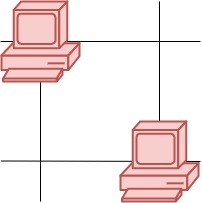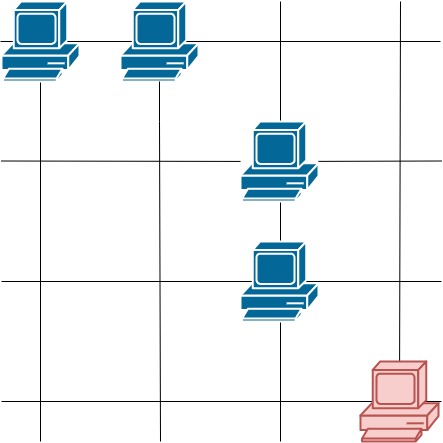iven a m * n grid, where each cell is either 0 (empty) or 1 (obstacle). In one step, you can move up, down, left or right from and to an empty cell.
Return the minimum number of steps to walk from the upper left corner (0, 0) to the lower right corner (m-1, n-1) given that you can eliminate at most k obstacles. If it is not possible to find such walk return -1.
Example 1:
Input:
grid =
[[0,0,0],
[1,1,0],
[0,0,0],
[0,1,1],
[0,0,0]],
k = 1
Output: 6
Explanation:
The shortest path without eliminating any obstacle is 10.
The shortest path with one obstacle elimination at position (3,2) is 6. Such path is (0,0) -> (0,1) -> (0,2) -> (1,2) -> (2,2) -> (3,2) -> (4,2).
Example 2:
Input: grid = [[0,1,1], [1,1,1], [1,0,0]], k = 1 Output: -1 Explanation: We need to eliminate at least two obstacles to find such a walk.
Constraints:
grid.length == mgrid[0].length == n1 <= m, n <= 401 <= k <= m*ngrid[i][j] == 0 or 1grid[0][0] == grid[m-1][n-1] == 0
Solution: BFS
State: (x, y, k) where k is the number of obstacles along the path.
Time complexity: O(m*n*k)
Space complexity: O(m*n*k)
C++
|
1 2 3 4 5 6 7 8 9 10 11 12 13 14 15 16 17 18 19 20 21 22 23 24 25 26 27 28 29 30 31 32 33 |
// Author: Huahua, 8 ms, 10.5 MB class Solution { public: int shortestPath(vector<vector<int>>& grid, int k) { const vector<int> dirs{0, 1, 0, -1, 0}; const int n = grid.size(); const int m = grid[0].size(); vector<vector<int>> seen(n, vector<int>(m, INT_MAX)); queue<tuple<int, int, int>> q; int steps = 0; q.emplace(0, 0, 0); seen[0][0] = 0; while (!q.empty()) { int size = q.size(); while (size--) { int cx, cy, co; tie(cx, cy, co) = q.front(); q.pop(); if (cx == m - 1 && cy == n - 1) return steps; for (int i = 0; i < 4; ++i) { int x = cx + dirs[i]; int y = cy + dirs[i + 1]; if (x < 0 || y < 0 || x >= m || y >= n) continue; int o = co + grid[y][x]; if (o >= seen[y][x] || o > k) continue; seen[y][x] = o; q.emplace(x, y, o); } } ++steps; } return -1; } }; |
Solution 2: DP
Time complexity: O(mnk)
Space complexity: O(mnk)
Bottom-Up
|
1 2 3 4 5 6 7 8 9 10 11 12 13 14 15 16 17 18 19 20 21 22 23 24 |
// AC 236 ms class Solution { public: int shortestPath(vector<vector<int>>& grid, int k) { constexpr int kInf = 1e9; const int m = grid.size(); const int n = grid[0].size(); vector<vector<vector<int>>> dp(m + 2, vector<vector<int>>(n + 2, vector<int>(k + 1, kInf))); dp[1][1][0] = 0; for (int s = 0; s < 3; ++s) for (int i = 1; i <= m; ++i) for (int j = 1; j <= n; ++j) { const int o = grid[i - 1][j - 1]; for (int z = 0; z + o <= k; ++z) dp[i][j][z + o] = min(dp[i][j][z + o], min({dp[i - 1][j][z], dp[i][j - 1][z], dp[i + 1][j][z], dp[i][j + 1][z]}) + 1); } int ans = *min_element(begin(dp[m][n]), end(dp[m][n])); return ans >= kInf ? -1 : ans; } }; |
Top-Down
|
1 2 3 4 5 6 7 8 9 10 11 12 13 14 15 16 17 18 19 20 21 22 23 24 |
class Solution { public: int shortestPath(vector<vector<int>>& grid, int K) { constexpr int kInf = 1e9; const vector<int> dirs{0, 1, 0, -1, 0}; const int m = grid.size(); const int n = grid[0].size(); vector<vector<vector<int>>> mem(m + 2, vector<vector<int>>(n + 2, vector<int>(K + 1, -1))); vector<vector<int>> seen(m + 2, vector<int>(n + 2)); function<int(int, int, int)> dp = [&](int x, int y, int k) { if (x < 1 || x > n || y < 1 || y > m || k < 0 || seen[y][x]) return kInf; if (x == 1 && y == 1) return 0; if (mem[y][x][k] != -1) return mem[y][x][k]; seen[y][x] = 1; int ans = kInf; for (int i = 0; i < 4; ++i) ans = min(ans, 1 + dp(x + dirs[i], y + dirs[i + 1], k - grid[y - 1][x - 1])); seen[y][x] = 0; return mem[y][x][k] = ans; }; const int ans = dp(n, m, K); return ans >= kInf ? -1 : ans; } }; |


